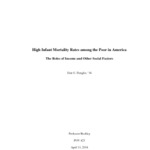High Infant Mortality Rates among the Poor in America: The Roles of Income and Other Social Factors

View/
Author
Dengler, Erin G.
Subject
Washington and Lee University, Shepherd Poverty Program
Infants -- Mortality -- Statistics
Poverty
Prenatal care
Postnatal care
Housing
Metadata
Show full item recordDescription
Erin G. Dengler is a member of the Class of 2014 of Washington and Lee University. Capstone; [FULL-TEXT FREELY AVAILABLE ONLINE] Many causes of infant mortalities, both neonatal and postnatal, are due to unpreventable congenital malformations. The other causes are largely preventable. Prenatal care, adequate maternal nutrition, and abstinence from substance abuse can help prevent both preterm births and LBW infants. After birth, safe sleeping conditions and an adequate home environment can prevent SIDS and the development of respiratory diseases, which are both leading causes of postneonatal mortality. Given today's world of modern medicine, one would think the overall infant mortality rate would be low, especially given the fact that many causes of infant mortality are readily preventable. However, in 2010, disorders related to LBW/preterm delivery and SIDS were two of the three leading causes of the 24,586 infant mortalities contributing to America's relatively high infant mortality rate of 6.15 infant deaths per 1,000 births. Moreover, this high infant mortality rate is not evenly distributed. Certain populations face rates of infant mortality that greatly exceed rates of other groups. Of specific concern is the disparate infant mortality rates based on income. Infants of mothers with higher incomes are less likely to die than infants born to mothers with lower incomes. The distribution of infant mortality rates amongst different populations should raise some red flags. This problem regarding American infant mortality deserves deep investigation. [From Introduction]